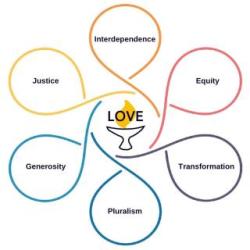 (Article is by guest writer Rob Wheeler. See bio below.)
(Article is by guest writer Rob Wheeler. See bio below.)
“Make your own Bible.
Select and collect all the words and sentences
that in all your reading have been to you
like the blast of triumph out of Shakespeare,
Seneca, Moses, John and Paul.” ~ Ralph Waldo Emerson ~“I must create a system
or be enslaved by another man’s.
I will not reason and compare:
my business is to create.” ~ William Blake ~
Compose a Florilegium
If you are a spiritual naturalist I have some bad news for you.
But I also have some good news—so read on!
The bad news is that when in life you find yourself confronted with suffering, pain and misfortune and in need of consolation and guidance, you have no sacred and authoritative scriptures to turn to for inspiration.
On the other hand, the good news is that you have access to every work of sacred scripture and secular literature that the world has ever produced, access especially enhanced by the advent of the Internet! You can therefore take Emerson’s advice and compose your own, personal, ‘bible’ out of fragments that strike you as authoritative. The book in which you record your personal anthology of extracts is known as a ‘commonplace book’ and the practice of making the collection is known as ‘commonplacing’.
From the Middle-ages up to the 19th century anyone who had the slightest pretension to be educated and cultivated kept a commonplace book and would often share it with friends who might then copy entries into their own notebook. Students were instructed to keep a commonplace book and authors, like the English philosopher John Locke, published sophisticated schemes for indexing them. It was not until high-volume cheap printing became universal that the practice started to decline. However, it is by no means dead as a cursory search on Google will show. Many people in the digital age still keep commonplace books.
The term ‘commonplace’ has now come to mean something that is cliched and unexceptional but that was not the original meaning. It comes from a latin phrase meaning ‘common headings’ and refers to the way that extracts are typically organised by theme. Writers such as the 16th century Dutch philosopher Erasmus provided prescriptive systems of headings based on spiritual topics including key religious doctrines and virtues.
Commonplace books in the past traditionally contained a veritable jumble of material: everything from family trees, prayers and proverbs to recipes, poems and magic spells. However, the particular genre of commonplace book to which I want to introduce you, and encourage you to keep, is called a Florilegium. This is an anthology of extracts from specifically spiritual and theological works and so is narrower in its focus than the typical commonplace book.
The word Florilegium literally means ‘a collection of flowers’, in this case flowers of great literature. The content can include aphorisms, maxims, proverbs, sayings, poems, songs, quotes, narrative chunks, etc, from books you have found helpful. The generic term for these extracts is ‘pithy’. Each ‘pithy’ should be very brief and ideally make just a single point.
I have been composing my own Florilegiums (or Florilegia if you want to be pedantic!) for several years now and what follows are five tips for composing your own. I have written the advice quite prescriptively, as these are the things that I have found work for me, but remember they are only tips and you should adapt them to your own needs.
Choose analogue or digital decisively
You can choose to write your ‘pithies’ by hand in a notebook (analogue) or use a computer to record them digitally. Both methods have their advantages and disadvantages but the important thing is to decide very early on how you are going to record, store and organise your Florilegiums. There is danger (and I know this from bitter personal experience) that if you flip-flop from one method to another you can generate a lot of time-consuming work for yourself as you reformat your material over and over.
Many keepers of commonplace books (and their close cousin the journal) like the simplicity of a hand-written notebook. A notebook is light, cheap and convenient to carry around with you. You don’t have to wait while it boots up and then find and open the relevant file. Just flip it open the moment you need it and you are ready to go. Analogue fans also claim that the process and final product is more aesthetically pleasing. This is not a trivial point as if the product is pleasing you will be more motivated in the long run to keep up the practice. Analogue fans often spend a lot of time choosing just the right pen and notebook (such as the Moleskine notebook. Did I say cheap?). There is also research to show that writing stuff by hand fixes it in your memory better than typing or copying & pasting.
The main disadvantage of the analogue method is that it is difficult to organise your pithies by theme in a linear book. One simple method of indexing is to reserve two pages at the beginning of your book on which to list your topics—one topic to a line. You then sequentially number each pithy as you copy it into your book and write the number of the pithy beside the theme in the index. This still involves the inconvenience of having to flip backwards and forwards in the book when reading through a particular theme.
An alternative analogue method is to copy your pithies onto 6 x 4 index cards and keep them organised by theme in a card box. This method also allows you to write comments on the pithy on the reverse of the card. However, the difficulty here is that unless you duplicate cards each pithy can only be in a single category. It’s also less portable than a notebook.
Owing to the disadvantages of analogue methods (and my extremely poor handwriting!) I have opted for composing my own Florilegiums digitally. I personally use a simple wordprocessor but it is worth mentioning that a lot of commonplacers recommend using Evernote as it allows hash-tags representing your themes to be attached to each pithy. Collections can then be exported by theme, saving you a lot of work sorting and selecting.
Pick promiscuously
Initially collect far and wide, allowing your whims to guide you, and don’t think too long and hard about which pithies to choose. This is where the analogy with a collection of flowers is apt. If you like the colour or smell of a saying or proverb just pick it. The only constraining factor should be length.
Most of your pithies will be just a couple of lines long but in general you should keep them to under 150 words maximum. My own practice is to copy one pithy per page in my wordprocessor. I create an A5 landscape template with automatic page numbering (so the page number becomes the index number of the pithy) and I use a 14 point font. If I can’t fit a pithy into that frame then I edit it down.
You should also note the provenance of the pithy; at least the name of the author if you can and a web link to the author, book or article. However, this is not an academic exercise so you don’t have to be too strict about it.
Review critically
Having whimsically collected your bunch of pithies, the next stage is to thoroughly review and evaluate each of them critically to check whether they are worth saving in your collection. On reflection do you find the pithy bland, cliched, facile? Is the same point expressed more succinctly and insightfully by an alternative pithy? If so bin it. Only keep the good stuff. On the other hand don’t throw a pithy out just because you disagree with it or believe it to be false. Your pithies serve four functions: Inspiration, Consolation (in the face of pain, suffering or loss), Navigation (practical and ethical guidance) and Provocation. This last is a radical break with traditional spiritual reading.
The usual practice is to select only those writings that support the dogma of your own spiritual tradition. But as rationalists we should not be simply seeking to bolster our preconceived ideas and prejudices. Rather we should be challenging and provoking ourselves to think carefully about what we believe and rooting out our errors. Juxtaposing one pithy we find attractive against a contradictory one can force us to clarify our own thinking. For instance I found myself collecting quotes on attitudes towards nature and discovered that they started to fall into two contradictory categories: romantic and anti-romantic. These four give you an idea:
“Nature never did betray
the Heart that Loved her.” ~ William Wordsworth ~“Nature never deceives us;
it is we who deceive ourselves.” ~ Jean-Jacques Rousseau ~“Nature will tell you a direct lie if she can.” ~ Charles Darwin ~
“Some people mistakenly think nature is very nice
and benevolent and never betrays.” ~ Margaret Atwood ~
So which of these views is correct?
Organise thematically
Whether you are an analogue or a digital collector I recommend that you write a string of hash tags after each pithy as you review it as this enables you to organise them thematically later. I use a convention like this for the four pithies above: #nature#benevolence#trust#deception#
I can then search for, say, #benevolence# and manually copy & paste the associated pithies to a separate file representing the theme.
The key point is not to start with a list of preconceived themes but to allow them to emerge organically. This is the second place where we break with tradition. As mentioned above Erasmus, among others, published a system of headings that collectors were supposed to use as a framework on which to hang their extracted passages. This simply confirmed existing beliefs and values and was not intended to challenge them in any way. Nowadays there is widespread suspicion and rejection of big systems whether in politics, religion or philosophy. We no longer feel confident about swallowing ‘grand narratives’ like Christianity, Buddhism, Stoicism or Marxism whole. Big systems give us spiritual indigestion! We want to pick and mix.
The old method was to start with foundations, like building a house, and then fill in the detail above. The method I am recommending here is more like composing a mosaic. Start by collecting the fragments and then see what structure emerges from it. What you will discover at the end of this process is what amounts to your personal framework and content of spirituality. Will it match up with what others have developed or will there be major points of contradiction? It would be interesting to find out.
Read and remark routinely
Among the many things that religions teach us is the value of routine and repetition. The calendar of annual celebrations and the daily and weekly recitation of liturgy gives life a rhythm and a framework. The process I am recommending here of collecting, reviewing, organising and reading should not be a one-off exercise but adopted as a routine activity. In addition to passively re-reading your pithies by theme from time to time you should also comment on them—in particular whether you agree or disagree with them and why. This is where the practice of commonplacing overlaps with journaling. By numbering each pithy sequentially you can refer to them in your reflective journal and use them as provocations for your reflective thinking and writing.
It is quite possible that you are already pursuing a practice like this but have just never heard of the terms Commonplace book or Florilegium. I’d be interested to know if anyone else in SNS is doing this and what method you use. Perhaps SNS could become a hub where we exchange, compare and discuss our personal florilegiums. It could help to define and clarify our different views of what spirituality amounts to.
Subscribe to The Spiritual Naturalist Society
Learn about Membership in the Spiritual Naturalist Society
__________
The Spiritual Naturalist Society works to spread awareness of spiritual naturalism as a way of life, develop its thought and practice, and help bring together like-minded practitioners in fellowship.
Bio: Rob Wheeler graduated many years ago from the University of Kent, Canterbury, UK, in philosophy and theology and since then has, at various times, been an assistant hospital manager, a social worker, an IT systems manager, a software developer and a college lecturer. He is now happily retired and living in south east UK, where he had been running a pub philosophy group called ‘The Stoa’ (stoa.org.uk) for the past 13 years and occasionally officiating at weddings, baby namings and funerals as a Humanist celebrant.
















